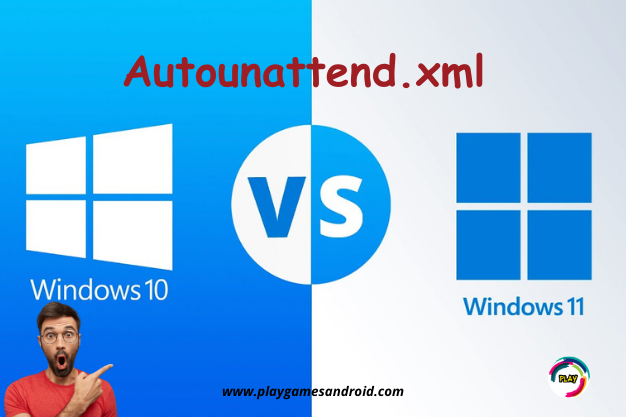Optimize Windows 10/11 Installation with Autounattend.xml: Automate, Remove Bloatware, and Boost System Performance Effortlessly.
Installing Windows can be time-consuming and repetitive. Fortunately, there’s a way to streamline and automate this process using a powerful tool: the Autounattend.xml file. This file allows you to skip unnecessary steps, apply optimizations, and customize your Windows 10 or 11 installation to fit your needs perfectly.
In this guide, we’ll explore what Autounattend.xml is, its features and optimizations, and how to use it for faster, more efficient installations. Whether you’re a tech enthusiast or a professional IT administrator, this guide is for you.
What is Autounattend.xml?
The Autounattend.xml file is a Windows answer file used to automate installations. It contains predefined instructions that guide the Windows setup process, eliminating the need for manual input. This includes tasks like choosing the edition of Windows, removing unnecessary apps, and applying performance tweaks.
I’ve created and fine-tuned an optimized Autounattend.xml file, inspired by contributions from sources like Memory’s Tech Tips and Chris Titus Tech. With this file, you can:
- Automate the entire Windows installation process.
- Bypass system requirements for unsupported hardware.
- Remove bloatware for a cleaner and faster system.
- Optimize performance right from the start.
Key Features and Optimizations of Autounattend.xml
1. Skip Windows 11 System Requirements
Windows 11 imposes strict hardware requirements, such as TPM (Trusted Platform Module) and Secure Boot. The Autounattend.xml file includes commands to bypass these checks, enabling installation on unsupported systems.
- BypassTPMCheck: Skips the TPM verification.
- BypassSecureBootCheck: Disables Secure Boot checks.
- BypassRAMCheck, CPUCheck, StorageCheck: Allows installation on devices with lower specs than the official requirements.
This is particularly useful for older PCs or devices that don’t meet Microsoft’s criteria but are still functional.
2. Choose Any Windows Edition
The file forces the installer to display all available Windows editions, such as Home, Pro, or Enterprise. This flexibility is achieved by generating an ei.cfg file during installation, letting you manually select the desired edition.
This feature is ideal for:
- Testing different editions of Windows.
- Installing specific versions for business or personal use.
- Ensuring compatibility across multiple devices.
3. Remove Pre-Installed Bloatware
Windows often comes loaded with unnecessary pre-installed applications (bloatware) that consume system resources. The Autounattend.xml file integrates a PowerShell script to remove unwanted apps, including:
- 3D Viewer, Skype, OneDrive, Teams, and more.
- Unnecessary Xbox-related apps, like Xbox Console Companion and Xbox Game Bar.
- Default utility apps like Weather, Groove Music, and Solitaire Collection.
By starting with a cleaner installation, your system will be faster, lighter, and more efficient.
4. Performance Optimizations Using WinUtil
Inspired by Chris Titus Tech’s Windows Utility, the file applies advanced system tweaks to maximize performance. Key optimizations include:
- Ultimate Performance Mode: Activates a high-performance power plan, ideal for gaming or resource-heavy tasks.
- Streamlined Processes: Optimizes memory usage by splitting
svchost.exeprocesses for better stability. - OneDrive and Teams Removal: Prevents these apps from starting automatically, saving system resources.
5. Registry Tweaks for Privacy and Usability
The file includes registry modifications to enhance privacy, usability, and system responsiveness. Some highlights:
- Telemetry Disablement: Reduces data sharing with Microsoft to protect user privacy.
- Cortana Removal: Disables the assistant to improve system speed.
- Streamlined Start Menu: Customizes the Start Menu for a cleaner and more intuitive experience.
6. Post-Installation Automation
To ensure your system is fully optimized, the Autounattend.xml file runs scripts after installation. These scripts handle:
- Registry Modifications: Ensures system-wide tweaks for all user accounts.
- Context Menu Additions: Adds useful options like “Open Command Prompt Here” for increased productivity.
How to Use Autounattend.xml
Using the Autounattend.xml file is simple:
- Prepare a Bootable USB Drive
- Create a bootable USB with Windows installation files.
- Add the Autounattend.xml File
- Copy the Autounattend.xml file to the root of the USB drive.
- Start the Installation
- Boot from the USB drive and begin the Windows installation.
- The setup process will automatically follow the instructions in the file, requiring no manual input.
This method is perfect for IT professionals who need to deploy systems quickly or users looking for a hassle-free installation process.
Benefits of Using Autounattend.xml
1. Time Savings
By automating tedious installation steps, the file significantly reduces setup time.
2. Improved Performance
From bloatware removal to advanced optimizations, your system is lean and fast from the start.
3. Enhanced Customization
Choose your preferred Windows edition and tailor the installation to your exact requirements.
4. Better Privacy
With telemetry disabled and intrusive features removed, your system respects your personal data.
Download the Autounattend.xml File
You can download the pre-configured Autounattend.xml file for free by supporting my content through the Mestres da Informática channel. The file includes all the optimizations discussed, ensuring a smooth and efficient installation.
[Download Autounattend.xml]
FAQs
Is Autounattend.xml safe to use?
Yes, it’s safe when sourced from reliable providers like the Mestres da Informática channel.
Can I customize the Autounattend.xml file?
Absolutely! You can edit the file to include additional tweaks or remove settings that don’t align with your needs.
Does it work on all Windows versions?
The file is specifically optimized for Windows 10 and 11.
What if I encounter issues during installation?
You can adjust the file or consult documentation on specific configurations to resolve compatibility issues.
Conclusion
The Autounattend.xml file is a game-changer for anyone looking to streamline their Windows installation process. By automating steps, removing unnecessary apps, and applying performance tweaks, it ensures a cleaner, faster, and more personalized setup.
Whether you’re deploying systems in bulk or setting up your own PC, this tool saves time and effort while delivering a high-performing system right out of the box. Try it out and experience the difference.
- Disable MPO in Windows: Boost PC Performance Instantly 2025
- Marvel Rivals hits record-breaking 444k players on Steam
- Indiana Jones Arrives on GeForce NOW with New Titles! 2025












Facebook comments